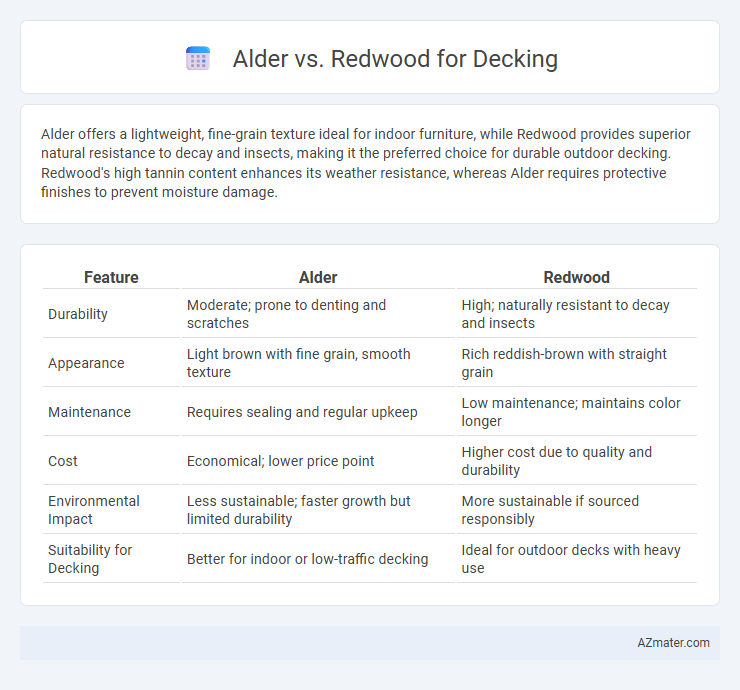Alder offers a lightweight, fine-grain texture ideal for indoor furniture, while Redwood provides superior natural resistance to decay and insects, making it the preferred choice for durable outdoor decking. Redwood's high tannin content enhances its weather resistance, whereas Alder requires protective finishes to prevent moisture damage.
Table of Comparison
| Feature | Alder | Redwood |
|---|---|---|
| Durability | Moderate; prone to denting and scratches | High; naturally resistant to decay and insects |
| Appearance | Light brown with fine grain, smooth texture | Rich reddish-brown with straight grain |
| Maintenance | Requires sealing and regular upkeep | Low maintenance; maintains color longer |
| Cost | Economical; lower price point | Higher cost due to quality and durability |
| Environmental Impact | Less sustainable; faster growth but limited durability | More sustainable if sourced responsibly |
| Suitability for Decking | Better for indoor or low-traffic decking | Ideal for outdoor decks with heavy use |
Introduction to Alder and Redwood Decking
Alder and Redwood are popular choices for decking due to their natural beauty and durability. Alder offers a smooth grain and warm, reddish-brown tones that enhance outdoor spaces, while Redwood is renowned for its rich color, resistance to decay, and strong structural integrity. Both woods require proper maintenance to retain their appearance and longevity when used for decks.
Physical Characteristics Comparison
Alder wood is lightweight and softer with a Janka hardness rating of around 590, making it easier to work with but less resistant to dents and scratches compared to redwood. Redwood is significantly more durable, featuring a Janka hardness of about 420, but its high natural resistance to decay and insects ensures long-lasting performance in outdoor decking. Both woods offer attractive grain patterns, but redwood's better dimensional stability minimizes warping and splitting, making it more suitable for high-moisture environments.
Durability and Lifespan
Redwood offers superior durability and a lifespan of 20 to 30 years due to its natural resistance to rot, insects, and decay, making it an ideal choice for decking in various climates. Alder, while attractive and more affordable, has a lower resistance to moisture and insect damage, typically lasting around 10 to 15 years when properly sealed and maintained. Choosing redwood enhances long-term investment by minimizing repairs and replacement, particularly in outdoor environments exposed to harsh weather.
Resistance to Decay and Insects
Redwood offers superior resistance to decay and insects compared to alder due to its natural oils and tannins that act as preservatives. Alder is a softer hardwood with less natural resistance, requiring additional treatment to withstand moisture and pest damage effectively. Choosing redwood for decking ensures longer durability and reduced maintenance in outdoor environments.
Workability and Installation
Alder wood offers excellent workability due to its fine, uniform grain, allowing for easy cutting, sanding, and shaping, making installation straightforward, especially for DIY projects. Redwood is also workable but has a softer texture that can be prone to dents and requires more care during handling and fastening to prevent damage. Both woods provide good installation options, but alder's consistent density often results in smoother finishes and faster assembly times.
Maintenance Requirements
Alder wood requires regular sealing and staining to protect against moisture and prevent warping, making it moderately high-maintenance for decking. Redwood offers superior natural resistance to decay and insects, reducing the frequency of maintenance and extending the lifespan of outdoor decks. Both woods benefit from annual cleaning, but redwood's inherent durability minimizes the need for frequent treatments compared to alder.
Aesthetic Differences and Color Options
Alder decking offers a warm, light brown hue with subtle reddish undertones that deepen over time, creating a smooth and consistent grain pattern ideal for refined outdoor spaces. Redwood features rich, deep reddish-brown tones with natural variations and striking knots, providing a bold, rustic aesthetic that enhances natural landscapes. Both woods age gracefully but alder develops a darker, more uniform patina while redwood fades to a soft, silvery-gray, influencing long-term aesthetic preferences.
Environmental Impact and Sustainability
Alder wood, sourced primarily from fast-growing trees in the Pacific Northwest, offers a renewable option with a smaller carbon footprint due to its rapid growth cycle and regional availability. Redwood, known for its natural resistance to decay, provides durability but often faces sustainability concerns linked to slower growth rates and potential overharvesting from old-growth forests. Choosing sustainably certified alder ensures reduced environmental impact, while redwood's long lifespan can offset its slower regeneration when responsibly managed.
Cost Analysis: Alder vs Redwood
Alder decking typically costs less than redwood, with prices ranging from $3 to $5 per square foot compared to redwood's $5 to $8 per square foot, making alder a more budget-friendly option. Redwood offers higher durability and natural resistance to insects and decay, which can reduce long-term maintenance expenses despite its higher upfront cost. Choosing between alder and redwood for decking ultimately depends on balancing initial budget constraints against expected longevity and maintenance costs.
Choosing the Best Wood for Your Deck
Redwood offers superior durability and natural resistance to decay and insects, making it an ideal choice for long-lasting decks in various climates. Alder wood, while more affordable and easier to work with due to its softer nature, lacks the same level of weather resistance and longevity, requiring more maintenance over time. Selecting the best wood for your deck depends on balancing initial cost, desired lifespan, and climate exposure, with redwood often preferred for premium, low-maintenance outdoor projects.

Infographic: Alder vs Redwood for Decking
 azmater.com
azmater.com